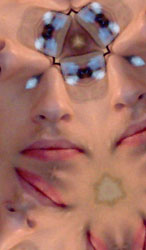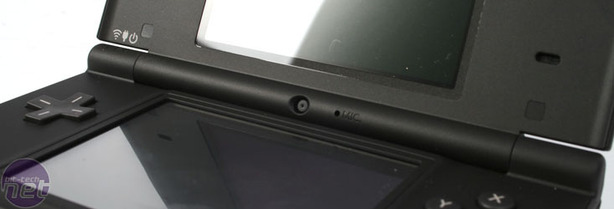
Software
Far more interesting than any of this though is the addition of two cameras to the DSi Lite, both of which tie into some rather fun little software that’s included in the DSi firmware. Note that we said ‘fun’, not ‘useful’ or ‘consistently entertaining’ though – that’ll be important later.The cameras are, it has to be said, crap though. Totally awful. There’s two of them, one on the inside hinge and another on the lid, but both of them are only 0.3 mega-pixel, which means that even at the 640x480 resolution all the images are saved at they still look dire. The photo quality is comparable to using a cameraphone in a snowstorm, while it's also on fire.
The camera software manages to balance much of this out though by merit of plentiful filters and quick-edit features. That the DSi would let you scrawl and add cartoon speech bubbles to photos was so predictable that even Shadow, the rabbit I had as a child who escaped from his hutch and ran away when my family was on holiday in Spain in 1992, was able to see it coming.
Nintendo has gone beyond the call of duty here though, namely by adding in some remarkably solid face recognition technology that picks faces out of crowds and automatically adds certain effects to them. Don’t get any ideas about using the DSi camera to get photos of people unwittingly though – the handheld gives off a loud shutter click with each snap.
Perhaps thankfully given the low image quality, the cameras can’t be used to record video either, despite the fact that the DSi makes more use of the built-in microphone. Like the camera, the microphone ties into some editing software which lets you take your audio clips (which can’t be more than a minute or so in length) and fiddle with them. You can reverse them, speed them up, alter pitch and all the usual jazz.
Cramming all of your pictures and audio files onto just 256MB of internal flash memory could prove a tad problematic after a while though, especially considering the other stuff you can download to the DSi (we’ll get to that). That’s probably why Nintendo has opted to include a SD card reader on the DSi too, figuring that making gamers carry around a bundle of SD cards with their game carts is probably cheaper than actually including a decent amount of storage. It’s like the Wii all over again.
This connectivity improvement has come at a cost though, as while the DSi gets an SD card reader it ends up losing the GBA slot and all the backward-compatibility tied to it. To most modern gamers, the sacrifice doesn’t amount to much, but if you’re the wily type who may have taken advantage of the plummeting price of GBA games then the loss of that slot is going to sting. It’s also worth bearing in mind that without the GBA slot you also lose compatibility with some more recent stuff – Guitar Hero: On Tour and the various DS rumble-packs, for example.
On the topic of card compatibility, it’s worth confirming that existing homebrew hardware won’t work with the DSi. Flat out, won’t work. Our R4 wouldn’t boot up and the DSi refused to recognise there was even a card inserted. Getting a DSi to download code from a single-cart multiplayer game on a DS Lite with an R4 in it did work though, so there may be a potential loophole there and we know for a fact that new homebrew gear is in the works.
The lifetime of future homebrew may be curtailed heavily however by the addition of new online functionality that brings with it the option for Nintendo to update the firmware and quickly patch holes and exploits in the code, rapidly rendering future versions of the R4 redundant.

MSI MPG Velox 100R Chassis Review
October 14 2021 | 15:04















Want to comment? Please log in.